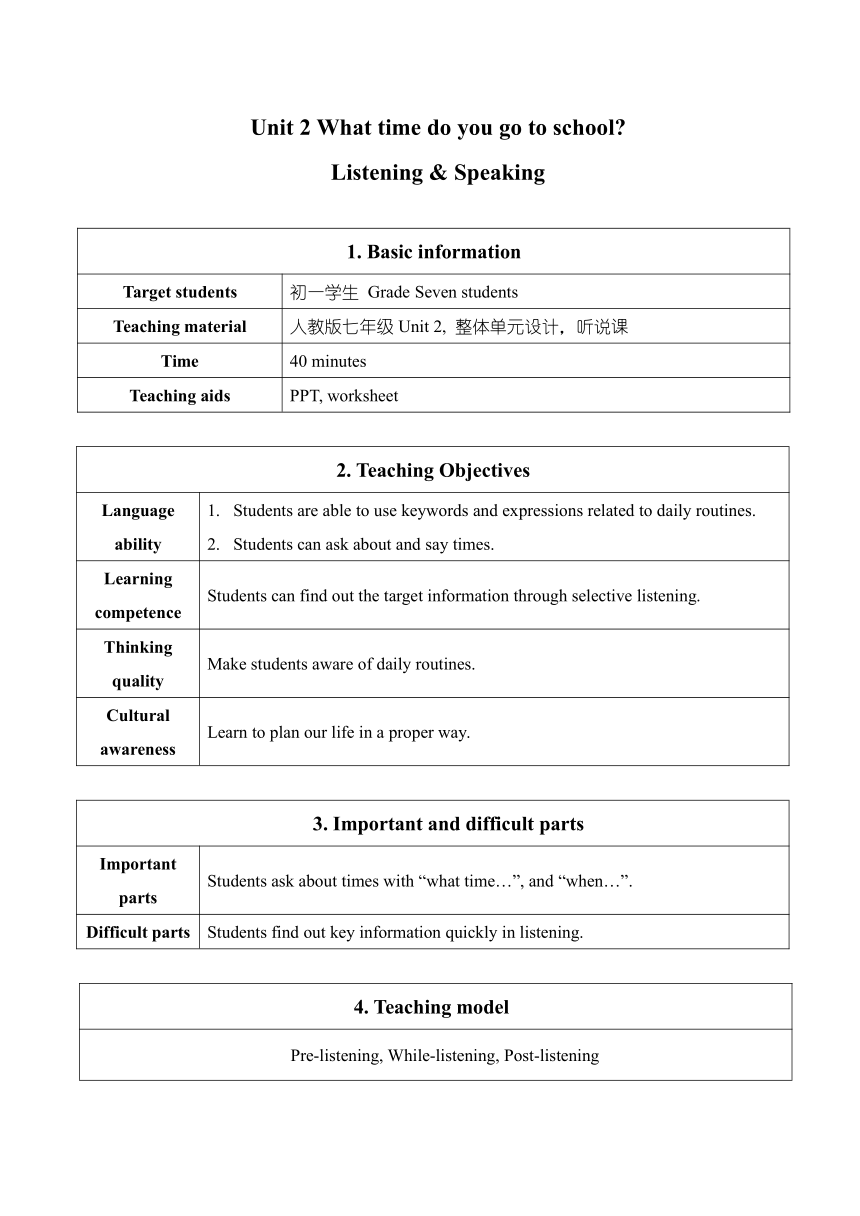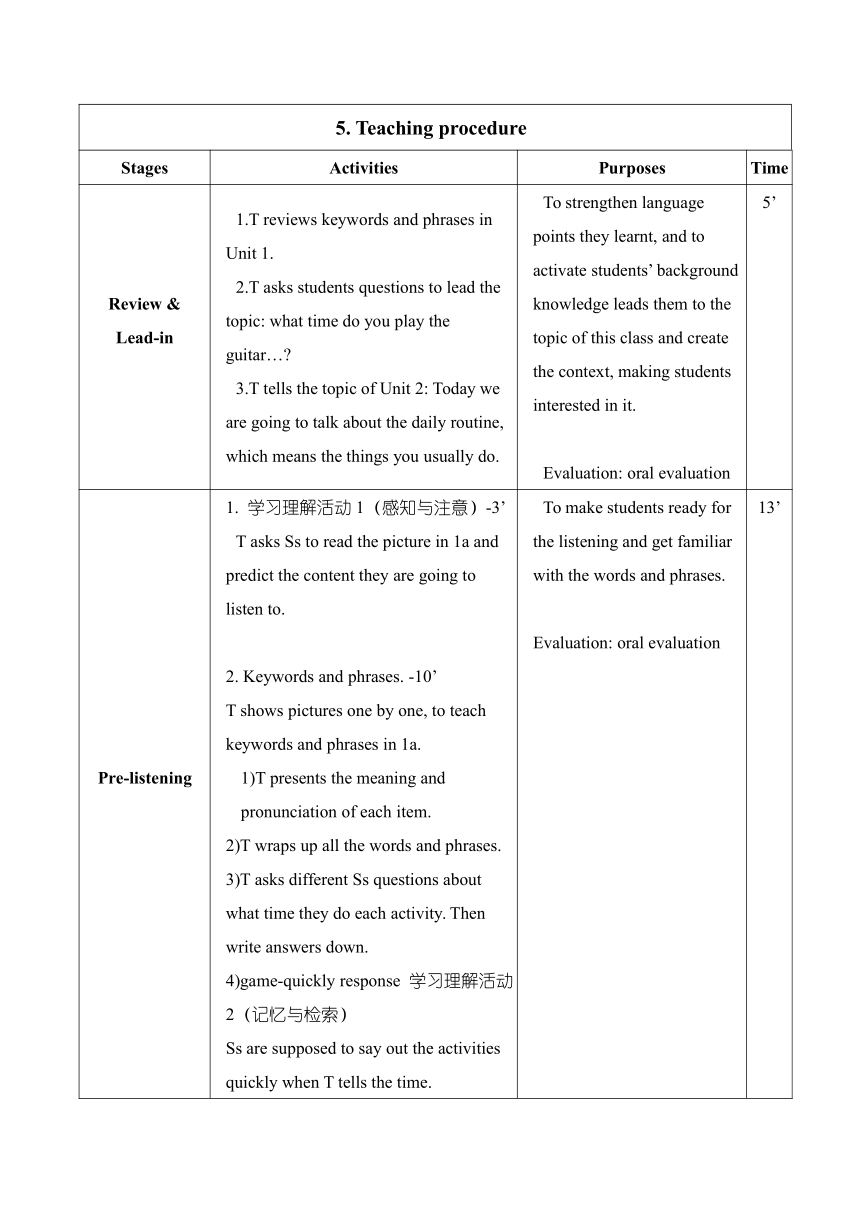人教版七年级下册Unit 2 What time do you go to school?听说课教案(表格式)
文档属性
| 名称 | 人教版七年级下册Unit 2 What time do you go to school?听说课教案(表格式) |  | |
| 格式 | docx | ||
| 文件大小 | 48.3KB | ||
| 资源类型 | 教案 | ||
| 版本资源 | 人教新目标(Go for it)版 | ||
| 科目 | 英语 | ||
| 更新时间 | 2023-09-01 08:39:40 | ||
图片预览


文档简介
Unit 2 What time do you go to school
Listening & Speaking
1. Basic information
Target students 初一学生 Grade Seven students
Teaching material 人教版七年级Unit 2, 整体单元设计,听说课
Time 40 minutes
Teaching aids PPT, worksheet
2. Teaching Objectives
Language ability Students are able to use keywords and expressions related to daily routines. Students can ask about and say times.
Learning competence Students can find out the target information through selective listening.
Thinking quality Make students aware of daily routines.
Cultural awareness Learn to plan our life in a proper way.
3. Important and difficult parts
Important parts Students ask about times with “what time…”, and “when…”.
Difficult parts Students find out key information quickly in listening.
4. Teaching model
Pre-listening, While-listening, Post-listening
5. Teaching procedure
Stages Activities Purposes Time
Review & Lead-in 1.T reviews keywords and phrases in Unit 1. 2.T asks students questions to lead the topic: what time do you play the guitar… 3.T tells the topic of Unit 2: Today we are going to talk about the daily routine, which means the things you usually do. To strengthen language points they learnt, and to activate students’ background knowledge leads them to the topic of this class and create the context, making students interested in it. Evaluation: oral evaluation 5’
Pre-listening 1. 学习理解活动1(感知与注意)-3’ T asks Ss to read the picture in 1a and predict the content they are going to listen to. 2. Keywords and phrases. -10’ T shows pictures one by one, to teach keywords and phrases in 1a. 1)T presents the meaning and pronunciation of each item. 2)T wraps up all the words and phrases. 3)T asks different Ss questions about what time they do each activity. Then write answers down. 4)game-quickly response 学习理解活动2(记忆与检索) Ss are supposed to say out the activities quickly when T tells the time. To make students ready for the listening and get familiar with the words and phrases. Evaluation: oral evaluation 13’
While-listening 1.学习理解活动3(感知与注意) T asks Ss to listen to the audio of 1b sentence by sentence. T can ask Ss questions to guide them find out key information, including time and activities. T can ask Ss: What time does Rick usually-- Let Ss say out the answer. 2.Complete 1a & 1b After listening to the audio, Ss can complete 1a & 1b and then check with their partners. Selective listening学习理解活动4(感知与注意) 1)T asks Ss to read the picture and sentence in 2a, so that they know they are going to pay attention to the key information. 2)Ss listen to the audio of 2a and complete 2a. 3)T tells Ss they can take notes while listening; they can write down the names first. 4)Ss complete 2b. T plays the audio to check the answers. To improve Ss’ listening strategies, they are supposed to have the ability to define the key information they will listen to, find out the key information, and take notes quickly. 12’
Post-listening 1.Interview.应用实践活动1(描述与阐释) 1)T reviews key sentences so that Ss can practice next. “What time do you usually get up ” “I usually get up at 6:00” … 2)T sends Ss a worksheet. (an interview table) 3)Ss can take interviews with 2 partners. Ask them questions and fill in the blanks. 2. Activity: My Great Day! 迁移创新活动1(创造与想象) Ss can design a great day; they can create a routine in that they can do anything they want. (Ss will get a table to fill out.) Train Ss’ abilities to listen and speak to enhance their language use and confidence. 10’
Listening & Speaking
1. Basic information
Target students 初一学生 Grade Seven students
Teaching material 人教版七年级Unit 2, 整体单元设计,听说课
Time 40 minutes
Teaching aids PPT, worksheet
2. Teaching Objectives
Language ability Students are able to use keywords and expressions related to daily routines. Students can ask about and say times.
Learning competence Students can find out the target information through selective listening.
Thinking quality Make students aware of daily routines.
Cultural awareness Learn to plan our life in a proper way.
3. Important and difficult parts
Important parts Students ask about times with “what time…”, and “when…”.
Difficult parts Students find out key information quickly in listening.
4. Teaching model
Pre-listening, While-listening, Post-listening
5. Teaching procedure
Stages Activities Purposes Time
Review & Lead-in 1.T reviews keywords and phrases in Unit 1. 2.T asks students questions to lead the topic: what time do you play the guitar… 3.T tells the topic of Unit 2: Today we are going to talk about the daily routine, which means the things you usually do. To strengthen language points they learnt, and to activate students’ background knowledge leads them to the topic of this class and create the context, making students interested in it. Evaluation: oral evaluation 5’
Pre-listening 1. 学习理解活动1(感知与注意)-3’ T asks Ss to read the picture in 1a and predict the content they are going to listen to. 2. Keywords and phrases. -10’ T shows pictures one by one, to teach keywords and phrases in 1a. 1)T presents the meaning and pronunciation of each item. 2)T wraps up all the words and phrases. 3)T asks different Ss questions about what time they do each activity. Then write answers down. 4)game-quickly response 学习理解活动2(记忆与检索) Ss are supposed to say out the activities quickly when T tells the time. To make students ready for the listening and get familiar with the words and phrases. Evaluation: oral evaluation 13’
While-listening 1.学习理解活动3(感知与注意) T asks Ss to listen to the audio of 1b sentence by sentence. T can ask Ss questions to guide them find out key information, including time and activities. T can ask Ss: What time does Rick usually-- Let Ss say out the answer. 2.Complete 1a & 1b After listening to the audio, Ss can complete 1a & 1b and then check with their partners. Selective listening学习理解活动4(感知与注意) 1)T asks Ss to read the picture and sentence in 2a, so that they know they are going to pay attention to the key information. 2)Ss listen to the audio of 2a and complete 2a. 3)T tells Ss they can take notes while listening; they can write down the names first. 4)Ss complete 2b. T plays the audio to check the answers. To improve Ss’ listening strategies, they are supposed to have the ability to define the key information they will listen to, find out the key information, and take notes quickly. 12’
Post-listening 1.Interview.应用实践活动1(描述与阐释) 1)T reviews key sentences so that Ss can practice next. “What time do you usually get up ” “I usually get up at 6:00” … 2)T sends Ss a worksheet. (an interview table) 3)Ss can take interviews with 2 partners. Ask them questions and fill in the blanks. 2. Activity: My Great Day! 迁移创新活动1(创造与想象) Ss can design a great day; they can create a routine in that they can do anything they want. (Ss will get a table to fill out.) Train Ss’ abilities to listen and speak to enhance their language use and confidence. 10’
同课章节目录
- Unit 1 Can you play the guitar?
- Section A
- Section B
- Unit 2 What time do you go to school?
- Section A
- Section B
- Unit 3 How do you get to school?
- Section A
- Section B
- Unit 4 Don't eat in class.
- Section A
- Section B
- Unit 5 Why do you like pandas?
- Section A
- Section B
- Unit 6 I'm watching TV.
- Section A
- Section B
- Review of Units 1-6
- Unit 7 It's raining!
- Section A
- Section B
- Unit 8 Is there a post office near here?
- Section A
- Section B
- Unit 9 What does he look like?
- Section A
- Section B
- Unit 10 I'd like some noodles.
- Section A
- Section B
- Unit 11 How was your school trip?
- Section A
- Section B
- Unit 12 What did you do last weekend?
- Section A
- Section B
